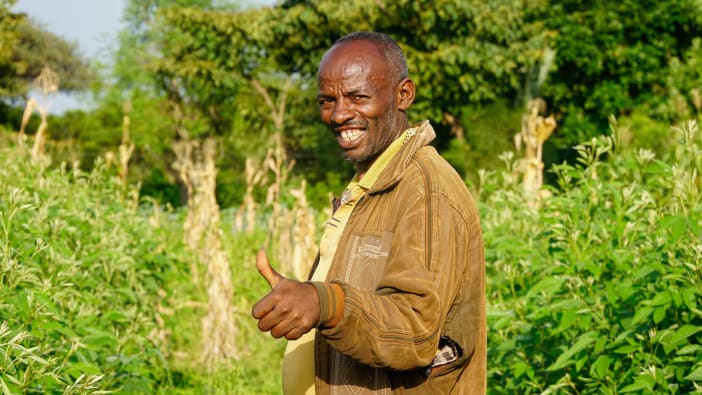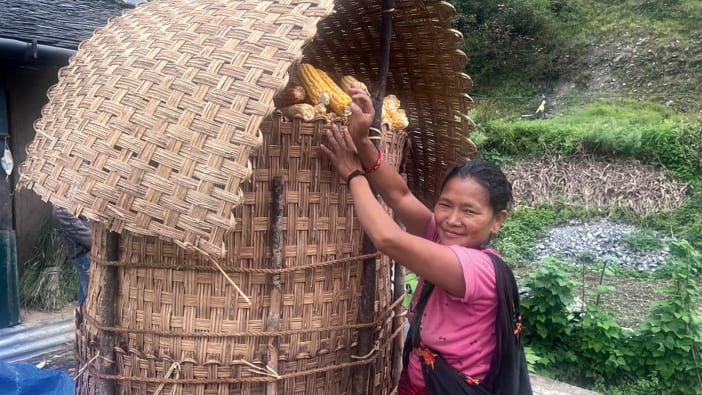Compiled from material by Dr Imuetinyan Igbinnosa and John Wibberley.
No farmer anywhere is without the problem of weeds. They will grow with every crop planted. They are reminders of a fallen world (Genesis 3:17-19). Every farmer struggles to overcome them so crops can grow well. Those who do not work to overcome them will receive a poor harvest (Proverbs 24:30-34).
Weeds take water and plant foods away from our crops. It is therefore much better to weed when weeds are small, before they do any real damage to crop production. They are easier to kill then, too.
The Bible gives encouragement that they will not always triumph over crops (Isaiah 55:13) and Jesus drew many lessons from them (Matthew 13:1-20 and 36-43).
There in one weed which is particularly damaging to crops. This is called Striga or Witchweed. Striga does not just take water and plant foods from the soil, it is actually a parasite, growing on the roots of the crops.
There are about 50 different species of Striga. The annual species are the most damaging weeds to the cereal crops, especially in areas with low and unreliable rainfall throughout Africa and Asia.
They include:
- Striga hermontheca (S sengegalensis) – the most common Striga in East, West and North Africa. It can grow up to half a metre in height and carries spikes of pink flowers which produce capsules containing masses of tiny, dark-coloured seeds. It is widespread in maize, millets, upland rice and sugar cane, but most severe in sorghum. It can wipe out an entire sorghum crop but more commonly reduces yields by one-third to one-quarter of their potential.
- Striga asiatica (S lutea) has red or white flowers. This species is a problem in India, Southern and Central Africa and the USA.
Many farmers do not realise the danger of Striga in their crops. They like the beautiful flowers growing in their crops and may even leave them while removing other weeds.
Striga should be seen as a very serious threat to the land. It makes it unsuitable for growing a number of crops, especially sorghum, for many years once the weeds build up. This is because of the huge number of seeds left in the soil for so long.
Areas of low rainfall and poor soil fertility, especially where erosion has removed topsoil and where cereal monoculture has been practised for years, are very suitable for the growth and development of Striga.
No single measure is enough to control Striga completely but a combination of practices can reduce the problem. These include:
Crop rotation
This is a first priority. Avoid long runs of cereal, especially of the same species. Grow crops which are not affected, or grow those which also stimulate the seeds of Striga to germinate so that they can be removed before the next cereal is planted. Such crops include cotton, groundnuts, sunflowers, sesame and green manure crop, Crotolaria (sunnhemp) – also grown for fibre.
Trap crops
Some plant species have been identified by scientists which stimulate Striga seeds to germinate but the parasite is then unable to penetrate the root. Without the supply of food from the plant root, the germinated Striga seed dies. Examples of trap plants include various green manure crops such as Abrus pricatorius, Calapogonium species, Mucuna flagellipes and Pueraria species. Green manure crops are ploughed in after about 4-6 weeks and greatly improve the fertility of the soil (See Footsteps no.7). Cowpeas, Vigna unguiculata and a variety of soyabean, Glycine max variety M90, can also be used as trap crops. These plants should be planted in rotation with other cultivated crops to reduce the amount of Striga in the soil. They are a very valuable way of tackling the problem
Densely planted sorghum species (including the forage type, Sudan grass) will stimulate a flush of Striga germination and seedlings can then be ploughed under before flowering. However this non-productive work and use of land is unattractive to small-holder farmers in dry areas!
Improved soil fertility
Adding composts, manures and fertilisers increases the competitive advantage the crop has over the weed. Nitrogen fertilisers such as urea, can inhibit or reduce the germination, growth and development of Striga. Experiments are still going on to find out the quantity of nitrogen needed to increase crop yields while at the same time inhibiting the growth of Striga. Maize is particularly helped in its battle against Striga by receiving extra nitrogen. Irrigated crops also suffer less.
Shallow cultivations
Use a hand hoe (or ox-drawn cultivator) to break up the surface of the soil between the rows of crops. But beware – unless repeated, such treatments can actually encourage more shoots to grow from damaged Striga plants.
Hand pulling
The complete removal and burning of Striga shoots before they can flower and reseed is the best way for the average small-holder farmer to control Striga – but beware! Unless repeated several times through the season it can encourage the weed to produce more new shoots if pulling is only an occasional and half-hearted effort.
Stubble cultivations and burial
These prevent post-harvest flowering of Striga by early ploughing under of the stubble of affected crops.
Resistant Varieties
Much research has been devoted to finding resistant or tolerant varieties for such crops as sorghum, cowpea, maize and millet. These resistant varieties suffer less damage from Striga. For example, in East Africa, the Dobbs types and Serena sorghums have some resistance. Farmers are advised to seek the latest local information on suitable varieties. Seeds of these resistant varieties can be obtained from research centres such as…
International Institute of Tropical Agriculture (IITA), PO Box 5320, Ibadan, Nigeria
IITA/SARFGRAD Project, Ouagadougou, Burkina Faso
ICRISAT, Patancheru, PO Andhra Pradesh 502324, India
Chemicals
Herbicides have also been developed but the cost of these generally makes their use unsuitable for the average small-holder farmer. Expert advice should be sought before attempting to control Striga in this way. Various chemicals (strigol, ethylene and cytokinins) have been found to encourage the germination of Striga seeds. Without a crop root to penetrate the seedlings quickly die.
Striga is a serious threat to food production. Once it has become established, it is very hard to remove completely. Only persistent, hard work can overcome this terrible, parasitic weed. Make sure all farmers in your area are aware of this problem. Please write in and tell us your experience with this difficult weed.
Dr Imuetinyan Igbinnosa is a scientist working for the Maize Research Programme at the International Institute of Tropical Agriculture, Ibadan, Nigeria.
John Wibberley is with the team of Work Mission Associates (WMA) and is a Visiting Fellow at the Royal Agricultural College.









